Ruth Ellen Gruber's Blog, page 7
October 18, 2012
Medieval Jewish Banquet in Italy
 Honey-nut sweets served on bay leaves. Photo © Ruth Ellen Gruber
Honey-nut sweets served on bay leaves. Photo © Ruth Ellen GruberBy Ruth Ellen Gruber
This post also appears on my En Route blog for the Los Angeles Jewish Journal.
Biancomangiare, lentil soup, twice-roasted goose with garlic, sweet and sour baked onion salad, Ippocrasso (spiced white wine), honey-nut sweets.
These were the dishes served at a Medieval Jewish banquet that recreated a meal that Jews in Italy might have eaten in the 14th and 15th centuries.
The event took place in Bevagna, a stunningly beautiful town in Italy's Umbria region -- whose historic center looks much the same as it did way back then.
 Entering Bevagna. Photo © Ruth Ellen Gruber
Entering Bevagna. Photo © Ruth Ellen GruberThe dinner, in a so-called Medieval Tavern in the heart of the town, capped a little academic conference on medieval Jewish life in Bevagna. I wrote about the dinner for JTA, in an article that also included the recipes for the dishes we ate. The first course was Biancomangiare, a puree made from chicken breast, almonds, rice flour, rose water and spices.
It was followed by a spicy lentil soup and then the main course: heaping platters of crisp, twice-roasted goose with garlic served with a warm salad of baked onions in sweet and sour sauce. The meal was rounded out by a form of spiced white wine called ippocrasso and honey-nut sweets served on fresh bay leaves.
"We love medieval cooking," said Alfredo Properzi, one of the dinner organizers. Properzi, a local doctor, belongs to a civic association that fosters study and re-enactment of life in the Middle Ages. The recipes for the dinner, he said, came from cookbooks of the period.
"One of the big differences was the spices that they used -- much more than today," he said. "Also, medieval cooks liked to use various spices to color food as well as season it.
The main speaker at the conference -- and my partner across the dining table -- was Ariel Toaff, an emeritus professor of Medieval and Rennaissance history at Bar Ilan University, who is the son of the reitred, longtime chief rabbi of Rome, Elio Toaff.
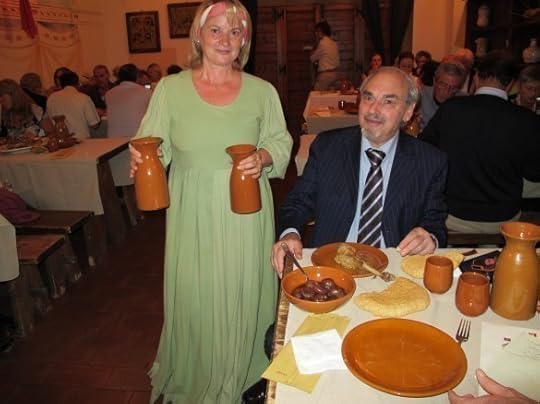 Ariel Toaff and a "medieval" waitress. Photo © Ruth Ellen Gruber
Ariel Toaff and a "medieval" waitress. Photo © Ruth Ellen GruberAriel's wonderful book, Love, Work and Death: Jewish Life in Medieval Umbria , is one of my favorite books -- partly because I spend a lot of my time in Umbria (where so very few Jews live today that when my entire family is with me, we make up one of the major Jewish centers in the region) and partly because the book reads like a spicy novel, set in Assisi, Orvieto, Bevagna, Todi, Perugia, Terni, Foligno -- and other towns that I'm very familiar with.
The chapter headings say it all: "Sex, Love, and Marriage;" "Love of Life and Intimations of Mortality;" "Meat and Wine;" "The House of Prayer;" " Outcasts from Society;" "Witchcraft, Black Magic, and Ritual Murder;" "Converts and Apostates;" "The Pattern of Discrimination;" "Merchants and Craftsmen;" "Doctors and Surgeons;" "Banks and Bankers."
Ariel also authored Mangiare alla Giudia, an influential history of Jewish food and eating in Italy, which has not been translated into English. Both books served as inspiration for the Bevagna dinner. (See an article on Italian Jewish cuisine in English by Ariel by clicking HERE.)
"The dinner organizers asked me what would be a typical dish for the menu, and I immediately told them goose because goose was, so to speak, the Jewish pig," he said. "It had the same function for the Jewish table as the pig did for non-Jews. Every part of the animal was used, including for goose salami, goose sausage and goose ‘ham,’ and foie gras was also a Jewish specialty."
Like today, he said, Jews in medieval times generally ate what the non-Jewish population did, adapting local recipes to the rules of kashrut.
"Biancomangiare was also made sweet with milk, pine nuts, almonds and raisins," he said. "But if it was served with a meat dish, the Jews would substitute almond milk for dairy milk."
Also like today, certain dishes became Italian Jewish favorites.
"Lentils were typically Jewish, and lentil soup was commonly eaten in the 14th and 15th centuries," Toaff said. "Being round, they symbolized the cycle of life. Another typical Jewish cooking style was sweet and sour, like the baked onion salad."
No Jews live today in Bevagna, but the city actively promotes its medieval history with festivals, pageants, Medieval dinners, and other events. The mayor told me that she was now thinking of how to add a Jewish component to all this -- and maybe even get a kosher winery started up.
There is particularly rich archival documentation about Bevagna's most prominent Jewish family in the 15th and early 16th centuries, the extended clan of the banker Abramo. Ariel Toaff recounts the story in great detail in "Love, Work and Death." it is a dramatic family saga that has a sort of rags to riches to rags again narrative framework.
Abramo owned banks in three towns, as well as a mansion, investment properties, farmland and many other holdings. But after his death in 1484, the family suffered a series of tragic setbacks, including deaths, bank failures and even a trumped-up claim by a young Bevagna boy that the family had lured him to their home and crucified him over Easter in 1485. Though apparently linked to a default on a loan to the Abramo bank by the boy’s mother, the allegations led to the banishment of several Abramo family members.
Click here to read full JTA article
Published on October 18, 2012 13:13
October 14, 2012
Revisiting a Secret Garden Jewish Cemetery in Czech Republic
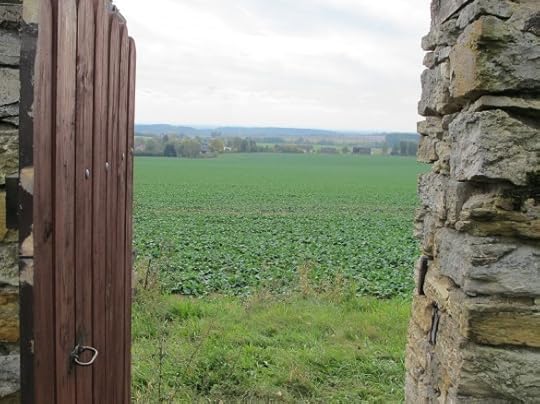
Looking out from the cemetery. All photos © Ruth Ellen Gruber
By Ruth Ellen Gruber
(This post also appears on my En Route blog for the Lost Angeles Jewish Journal.)
I spent part of this weekend at a bluegrass workshop in the little town of Male Svatonovice, in the north of the Czech Republic, near the Polish border. I was only there to observe, not to join the hundred or so students learning banjo, mandolin, guitar and bass, so I took time to drive half an hour through the back roads to revisit one of my favorite Jewish cemeteries -- the isolated walled graveyard at the tiny hamlet of Velka Bukovina.
The village is too small to appear even on many large scale maps. The Jewish population disappeared in the early 20th century as Jews moved out to bigger cities.
When I first visited, six years ago, while doing the update for my book National Geographic Jewish Heritage Travel, I stayed at a charming pension that was sort of near by. The son of the family who ran it helped me find the cemetery -- it is set alone in the middle of farm fields. There did not seem to be any way actually to reach the cemetery other than tramping across the field, so that is what I did. It was the height of summer, and I waded through maybe half a mile of waist-high weeds, grass, and, I guess, hay. (Thankful that I was wearing my cowboy boots.)
This time, the going was much easier. First, I could see the cemetery int he distance from the main road. And I easily found the one-lane paved road that led up near by it. I parked at the side, and found a sort of vehicle track through the grass leading to the cemetery. It was an easy path to walk. Could I have totally missed it when I went there the first time? Or is it new since I was there?

Whatever. I easily reached the cemetery and found the gate latched but not locked. Inside the absolute rectagular wall, it was just as I remembered -- a secret garden of a place, rather well maintained (I saw a wheelbarrow propped in a corner of the space) with irregular rows of gravestones exhibiting vividly carved inscriptions and decorations, many with a decidedly rustic touch -- the oldest date back to the mid-18th century. In the distance, I could see the autum colors in the nearby forest.
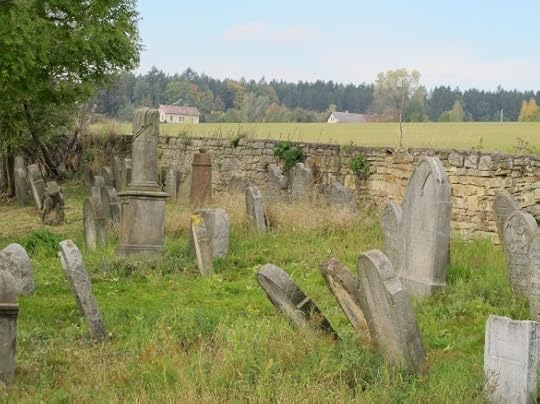 All photos © Ruth Ellen Gruber
All photos © Ruth Ellen Gruber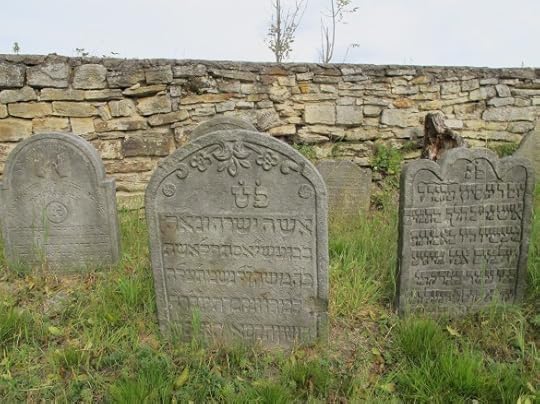
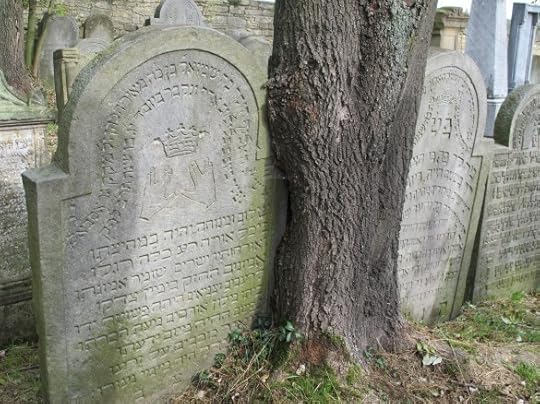
What I still consider one of the most moving aspects of this cemetery is also still there -- a park bench placed outside the gate, looking out at the fields. Does anyone ever ever ever come to use it? To sit and remember the community? To reflect on a world of changes?
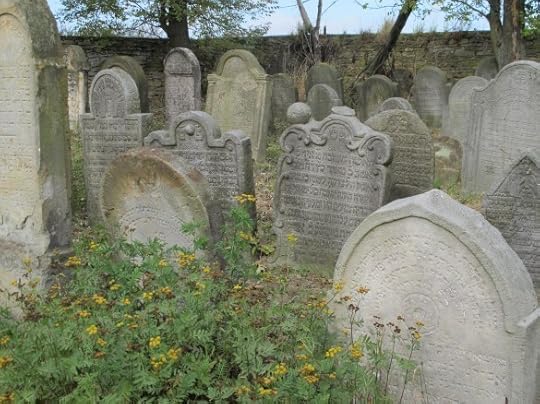

All photos © Ruth Ellen Gruber
Published on October 14, 2012 14:46
October 3, 2012
Lack of Funding Closes Museum Housing Sarajevo Haggadah
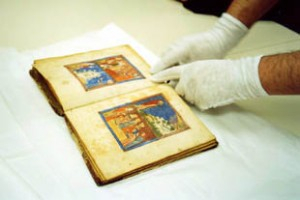 Sarajevo Haggadah in bank vault, 2001. Photo © Ruth Ellen Gruber
Sarajevo Haggadah in bank vault, 2001. Photo © Ruth Ellen GruberBy Ruth Ellen Gruber
This post also appears on my En Route blog for the LA Jewish Journal
The Bosnia-Herzegonia National Museum in Sarajevo, where the priceless Sarajevo Haggadah is kept, is being forced to close for lack of funds -- the latest in a number of major cultural institutions in Sarajevo forced to shut their doors due to political wrangling and the central government's halting of funds for culture.
In my brief JTA story I write that Jakob Finci, the longtime leader of the Jewish community in Sarajevo, said the museum, founded in 1888, would close on Thursday due to “lack of money, financing and support from the State.”
He called the decision “tragic,” but said he did not fear for the Sarajevo Haggadah, which, he said would be kept in a safe place.
The haggadah, handwritten in Spain in the 14th century and brought to Sarajevo after the expulsion of the Jews from Spain in 1492, has been owned by the museum since 1894.
During the Bosnian war in the 1990s, the lavishly illustrated, 109-page book became a symbol of the shattered dream of multi-ethnic harmony in Bosnia. After the war ended in 1995, the U.N. Mission, along with the Bosnian Jewish Community, the Joint Distribution Committee, and the Yad Hanadiv and Wolfenson Foundations, facilitated a $150,000 project to restore the Haggadah and prepare a secure, new, climate-controlled room in which to put it on display.
This was opened with a gala ceremony in December 2002. But Finci told JTA that, in recent years, the actual Haggadah was only displayed on four days a year – all the rest of the time a facsimile was shown.
In 2001, before it went on public display, I had the rare opportunity of viewing the Haggadah in the underground bank vault in Sarajevo where it was kept, when I accompanied a JDC delegation to Bosnia.
A bank functionary led us through corridors and down narrow stairways into a basement vault lined with safety deposit boxes.
Wrapped in white tissue paper, the Haggadah was removed from a sealed, blue metal lock box and placed on a table.
Wearing clean, white gloves, a staff member from the Sarajevo national museum then opened the book, turning over page after page to reveal the elegant Hebrew calligraphy and brilliantly colored and gilded illustrations.
An article in April in The Art Newspaper provided some background to the museum crisis.
The National Gallery closed to the public last September. It had been without a director and chief financial officer since May. The Historical Museum of Bosnia and Herzegovina, also in Sarajevo, was forced to shut its doors on 4 January after running out of money for maintenance and heating. Staff at both institutions have worked without pay since the respective closures.
The National and University Library, which has had no heating since early January, is next on the list of anticipated closures. [...]
The current crisis is a result of national elections held in 2010, which failed to create a coalition with a parliamentary majority. Without a functioning government, there was no funding for cultural institutions last year.
Museum administrators in Sarajevo say that grants from the new government, formed this February, will not solve the structural problem affecting the institutions. They believe that the institutions need to be funded at a national level if they are to operate effectively in the future. They also want a national cultural ministry to be created.
For further information on the culture crisis in Bosnia see the web site www.cultureshutdown.net
Published on October 03, 2012 08:58
October 2, 2012
Shana Tova!
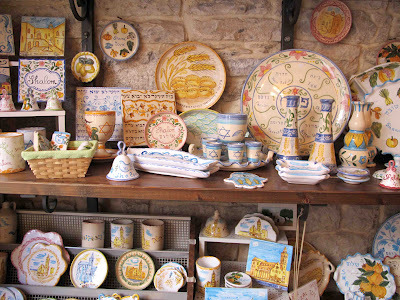 Jewish themed ceramic souvenirs at a shop in the medieval Jewish quarter of Trani, Italy. Photo © Ruth Ellen Gruber
Jewish themed ceramic souvenirs at a shop in the medieval Jewish quarter of Trani, Italy. Photo © Ruth Ellen GruberBy Ruth Ellen Gruber
With still a week to come in the autumn holiday season, I'd like to take the opportunity to wish all my readers a sweet, satisfying and stimulating new year -- and beyond!
I've taken a break from posting this past month or so, but I look forward to getting back into the swing of things very soon and posting regular reports, commentaries, images and links.
Meanwhile -- for a growing range of resources and news reports, please take a look at the web site that I am coordinating as a project of the Rothschild Foundation Europe: www.jewish-heritage-europe.eu
Published on October 02, 2012 07:28
August 26, 2012
Detailed look at a Jewish cemetery in Ukrainian Transcarpathia
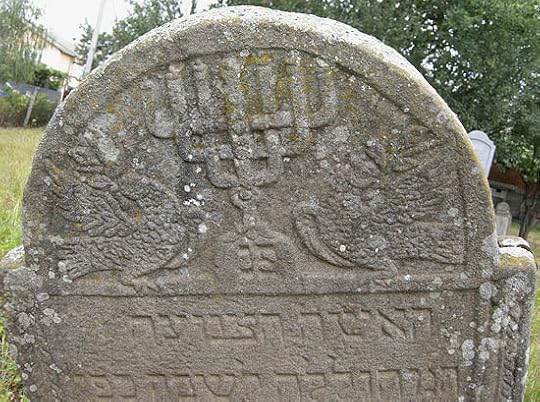 Photo courtesy of riowang.blogspot.com
Photo courtesy of riowang.blogspot.com Bottom of same gravestone. Epitaph reads: "Here is hidden the virtuous and praised woman, whose hand was open to the poor [Prov 31:20 in free rendering], Lady Scheindel, daugther of Moshe of the blessed memory. Dceased on day Rabbah [the last day of Sukkot] of Hoshana in 5605 [1845]. May her soul be bound in the bondage of the living." Photo and translation courtesy of riowang.blogspot.com
Bottom of same gravestone. Epitaph reads: "Here is hidden the virtuous and praised woman, whose hand was open to the poor [Prov 31:20 in free rendering], Lady Scheindel, daugther of Moshe of the blessed memory. Dceased on day Rabbah [the last day of Sukkot] of Hoshana in 5605 [1845]. May her soul be bound in the bondage of the living." Photo and translation courtesy of riowang.blogspot.com By Ruth Ellen Gruber
The elegant and informative riowang blog runs a very nice post -- with lots of photos -- about the Jewish cemetery in Tekovo/Tekehaza in Ukrainian Transcarpathia.
I have already linked to the very detailed and richly illustrated riowang posts about the Jewish cemetery and synagogue in Lesko, Poland - and since the author gave me permission to use his photos, I am re-posting some photos of Tekovo/Tekehaza here.
The post comments in particular on the large number and variety of gravestones marked by candlesticks.
Riowang noted that in Tekovo/Tekehaza
it is worth noting a special gravestone motif, which almost has its own school in the cemetery of Tekeháza: the large and diverse number of geometric candelabra. The presence of candelabra – as we have already seen in the cemetery of Lesko – is not unique in itself. We meet with them almost only on women’s graves, praising the Friday night candle-lighting and, beyond that, the light and warmth of the family home as well as the virtuous woman maintaining it. What is interesting in Tekeháza, however, is the large number and many variations of stylized, geometric candelabra.The many photographs on the post show candlesticks that are geometric and braided at the same time, as well as some that look like plants:
Once speaking about the candelabra, it’s worth to point out a special local form of this motif. About these gravestone decorations it is difficult to decide whether they are three-branch candelabra or stylized three-leaved plants.
For the stone pictured above, it notes:
On the top, two doves with their heads turned back surround a richly decorated seven-branch candelaber of an intertwined stem. The dove is a symbol of piety, while the candelaber of Friday evening and of the family home. At the bottom of the gravestone a snake is waving. The snake is a relatively rare motif on Jewish graves. In the Jewish cemetery of Warsaw we find an example of the snake biting its own tail, a symbol of eternity, while in the likewise Polish Jewish cemetery of Żabno, the snake attacking the lion on one of the stones represents the death. It is likely that the snake in Tekeháza is somehow related to this latter one.Read full post
Published on August 26, 2012 07:01
July 25, 2012
U.S. Special Envoy Hannah Rosenthal Visits her Family's Heritage Sites in Poland
This post also appears on my En Route blog for the Los Angeles Jewish Journal
By Ruth Ellen Gruber
Hannah Rosenthal, the U.S. Special Envoy to Monitor and Combat Anti-Semitism, took time out on a trip to Poland and Germany this month to honor her ancestors at sites of her own family history.
Rosenthal’s family came from what is now Bytom, Poland. All were murdered at Auschwitz in 1942 except for her father, who was the last Rabbi in Mannheim, Germany, and survived interment in Buchenwald.
In a post Tuesday on the State Department’s official blog, Rosenthal recounted that she visited sites in Bytom where her family had lived and also visited the Jewish cemetery there, hoping to find the graves who her grandmother and uncle, who had died before World War II “and therefore would have graves.”
Visiting Bytom, she wrote, was “both exhilarating and devastating.”
During her trip to Poland, she wrote, she met Jewish community leaders and representatives of the Auschwitz-Birkenau Foundation, the Forum for Dialogue Among Nations, and the Judaica Foundation.
On July 9, during her visit to Germany, Rosenthal took part in a ceremony in Mannheim at which a “stumbling stone” memorial was dedicated to her father. Stumbling stones are plaques the size of cobblestones that are placed on the street in front of houses in which Holocaust victims and survivors lived.

By Ruth Ellen Gruber
Hannah Rosenthal, the U.S. Special Envoy to Monitor and Combat Anti-Semitism, took time out on a trip to Poland and Germany this month to honor her ancestors at sites of her own family history.
Rosenthal’s family came from what is now Bytom, Poland. All were murdered at Auschwitz in 1942 except for her father, who was the last Rabbi in Mannheim, Germany, and survived interment in Buchenwald.
In a post Tuesday on the State Department’s official blog, Rosenthal recounted that she visited sites in Bytom where her family had lived and also visited the Jewish cemetery there, hoping to find the graves who her grandmother and uncle, who had died before World War II “and therefore would have graves.”
Visiting Bytom, she wrote, was “both exhilarating and devastating.”
When we went to see the gorgeous synagogue, where Dad had celebrated his Bar Mitzvah and loved to tell us great stories about, there was no synagogue. Just a dilapidated gray apartment building. When we went to the cemetery, we hoped to find the graves of my grandmother and uncle who died before the war—and therefore would have graves. But Polish activist Wlodzimierz Kac had something else in mind. He had researched my family and ended up showing us 18 Rosenthal graves. My grandmother Selma, my uncle Martin, great and great-great grandparents, great and great-great uncles, and aunts and cousins. Eighteen Rosenthals who we could honor. I am the last Rosenthal in my family.
Bytom now has not a single Jew and hardly any Jewish presence. Where once a bustling community thrived, there is not one single survivor. We visited two of the places Dad’s family had lived. He had described his home’s music room and parlors. Now the buildings are dark, dank, depressing. And mostly empty. We wondered how we could help restore a school or a prayer house, or clean up the cemetery, when there is no one to keep it up. The absence is profoundly present.
During her trip to Poland, she wrote, she met Jewish community leaders and representatives of the Auschwitz-Birkenau Foundation, the Forum for Dialogue Among Nations, and the Judaica Foundation.
I learned about the present-day Jewish community in Poland and civil society engagement on Jewish history and culture. These organizations are doing important work, fostering interaction between Jews and non-Jewish Poles through dialogue, education, and cultural exchange. Several programs focus specifically on fostering interaction among Polish non-Jewish and Jewish youth. It was moving to meet the extraordinary people working to keep the memory and spirit of Poland’s absent Jews alive.
On July 9, during her visit to Germany, Rosenthal took part in a ceremony in Mannheim at which a “stumbling stone” memorial was dedicated to her father. Stumbling stones are plaques the size of cobblestones that are placed on the street in front of houses in which Holocaust victims and survivors lived.
Published on July 25, 2012 13:12
This post also appears on my En Route blog for the Los An...
This post also appears on my En Route blog for the Los Angeles Jewish Journal
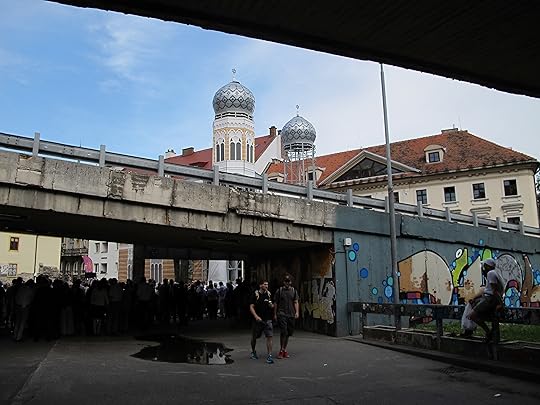 The replica of the Neolog Synagogue in Bratislava, next to the highway. Photo(c) Ruth Ellen Gruber
The replica of the Neolog Synagogue in Bratislava, next to the highway. Photo(c) Ruth Ellen GruberBy Ruth Ellen Gruber
I’ve already posted on this blog about the new ITunes app called Oshpitzin that uses smart phone technology to teach and tour pre-WW2 Jewish Oswiecim—the town where Auschwitz was built—which before the Holocaust was a majority Jewish town.
In this JTA story I write about how this project and the Lost City project in Bratislava—which puts back on the map the old Jewish quarter of the Slovak capital, which was utterly demolished by the Communist authorities in the late 1960s to built a new highway and bridge across the Danube. Centerpiece of the Lost City project is a replica of the destroyed Neolog synagogue, on the spot where it really did once stand.
In Poland and Slovakia, restoring awareness of a forgotten Jewish past
By Ruth Ellen Gruber · July 23, 2012
KRAKOW, Poland (JTA)—Thanks to a new iTunes app, new tourist routes and a towering replica of a destroyed synagogue, two “lost” Jewish cities in Europe are back on the map.
One is the historic Jewish quarter of Bratislava, the Slovak capital, which survived World War II only to be demolished by communist authorities in the late 1960s. The other is Oshpitzin—the prewar Yiddish name for Oswiecim, the once mainly Jewish town in southern Poland where the Auschwitz death camp was built.
The two projects differ in scope and structure, but their goals are the same: to restore awareness of the forgotten Jewish past in an effort to foster a better understanding of the present—for tourists and the locals.
Read full story here
Published on July 25, 2012 13:06
July 16, 2012
Wonderful Exhibit in Warsaw of Gwozdziec synagogue panels
A version of this post appeared on my En Route blog for the Los Angeles Jewish Journal
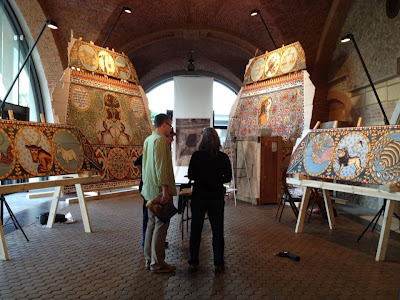 Preview of the Exhibition. Photo courtesy of Barbara Kirshenblatt-Gimblett
Preview of the Exhibition. Photo courtesy of Barbara Kirshenblatt-Gimblett
By Ruth Ellen Gruber
A wonderful exhibition opens today at the Arkady Kubickiego (Kubicki Arcade) of the Royal Castle in Warsaw and runs til the end of the month—the colorful ceiling panels that have been painted this summer as part of the Gwozdiec synagogue reconstruction project.
The reconstruction of an 85 percent scale model of the tall peaked roof and richly decorated inner cupola of the wooden synagogue that once stood in Gwozdziec (now in Ukraine) is a project of the Handshouse Studio and the forthcoming Museum of the History of Polish Jews—I wrote about the first stages of the project last summer, when students, master timber-framers and volunteers gathered in Sanok, southeastern Poland, to build the structure, using hand tools that would have been used centuries ago. The reconstructed roof and cupola will be a major installation at the new Museum, which is due to open in the autumn of 2013.
This summer, at workshops held in synagogues around Poland, teams of students and volunteers have been carrying out the colorful, elaborate paintings that cover in the interior of the cupola—and it is these that will be displayed for the next two weeks in Warsaw.
It’s terrific—and fascinating—work, and this will be a rare chance to see the panels up close before they are mounted as part of the cupola installation!
 Preview of the Exhibition. Photo courtesy of Barbara Kirshenblatt-Gimblett
Preview of the Exhibition. Photo courtesy of Barbara Kirshenblatt-GimblettBy Ruth Ellen Gruber
A wonderful exhibition opens today at the Arkady Kubickiego (Kubicki Arcade) of the Royal Castle in Warsaw and runs til the end of the month—the colorful ceiling panels that have been painted this summer as part of the Gwozdiec synagogue reconstruction project.
The reconstruction of an 85 percent scale model of the tall peaked roof and richly decorated inner cupola of the wooden synagogue that once stood in Gwozdziec (now in Ukraine) is a project of the Handshouse Studio and the forthcoming Museum of the History of Polish Jews—I wrote about the first stages of the project last summer, when students, master timber-framers and volunteers gathered in Sanok, southeastern Poland, to build the structure, using hand tools that would have been used centuries ago. The reconstructed roof and cupola will be a major installation at the new Museum, which is due to open in the autumn of 2013.
Its elaborate structure and the intricate painted decoration on the cupola ceiling will reproduce a form of architectural and artistic expression that was wiped out in World War II, when the Nazis put the torch to some 200 wooden synagogues in Eastern Europe. Many of them, like that in Gwozdziec, were centuries old and extraordinarily elaborate, with tiered roofs and richly decorative interior painting.
The Gwozdziec Synagogue, built in the 17th and 18th centuries, was a “truly resplendent synagogue that exemplified a high point in Jewish architectural art and religious painting,” the architectural historian Thomas C. Hubka, an expert on the building, has written.
This summer, at workshops held in synagogues around Poland, teams of students and volunteers have been carrying out the colorful, elaborate paintings that cover in the interior of the cupola—and it is these that will be displayed for the next two weeks in Warsaw.
It’s terrific—and fascinating—work, and this will be a rare chance to see the panels up close before they are mounted as part of the cupola installation!
Published on July 16, 2012 01:11
July 14, 2012
Smartphone App for Oshpitzin/Oswiecim
A version of post also appears on my En Route blog for the Los Angeles Jewish Journal

By Ruth Ellen Gruber
The latest Jewish travel app for smartphones and tablets takes you to a place that no longer exists except in memory: Oshpitzin.
Oshpitzin was the Jewish name for Oswiecim, the small town in southern Poland where the Nazis built Auschwitz which had a majority Jewish population before the Holocaust -- I’ve written a lot about the town and its difficulty in balancing its Holocaust identity with its pre-WW2 past, starting in the mid 1990s, when I dealt with the issue in the long chapter “Snowbound in Auschwitz” in my book Upon the Doorposts of Thy House: Jewish Life in East-Central Europe, Yesterday and Today, which was a sort of diary and meditation on nearly four days blocked in Oswiecim by a freak snowfall…...
Last year, the Auschwitz Jewish Center—a prayer, study and research center in Oswiecim—launched a project aimed at putting Oshpitzin back on the map. It started with a printed guidebook and followed on withan interactive web site, www.ospitzin.pl, that includes a map, pictures, history, testimonies and more.
Now, the Center as followed through with a smartphone App that can be used by armchair travelers as well as actual visitors to the town. It has an interactive map, videos, audio, photographs, etc.
Most of the sites the project—be it the guide book, the web site or the App—describes no longer exist. But it all entails a way to learn about the Jewish history (and general history) of a town that existed for hundreds of years before “Auschwtiz” changed its identity from a place of Jewish life into a place of Jewish murder.
As of now, the App is available in the iTunes store for IPhone and IPad—but it will soon be available on Android, too.


By Ruth Ellen Gruber
The latest Jewish travel app for smartphones and tablets takes you to a place that no longer exists except in memory: Oshpitzin.
Oshpitzin was the Jewish name for Oswiecim, the small town in southern Poland where the Nazis built Auschwitz which had a majority Jewish population before the Holocaust -- I’ve written a lot about the town and its difficulty in balancing its Holocaust identity with its pre-WW2 past, starting in the mid 1990s, when I dealt with the issue in the long chapter “Snowbound in Auschwitz” in my book Upon the Doorposts of Thy House: Jewish Life in East-Central Europe, Yesterday and Today, which was a sort of diary and meditation on nearly four days blocked in Oswiecim by a freak snowfall…...
Last year, the Auschwitz Jewish Center—a prayer, study and research center in Oswiecim—launched a project aimed at putting Oshpitzin back on the map. It started with a printed guidebook and followed on withan interactive web site, www.ospitzin.pl, that includes a map, pictures, history, testimonies and more.
Now, the Center as followed through with a smartphone App that can be used by armchair travelers as well as actual visitors to the town. It has an interactive map, videos, audio, photographs, etc.
Most of the sites the project—be it the guide book, the web site or the App—describes no longer exist. But it all entails a way to learn about the Jewish history (and general history) of a town that existed for hundreds of years before “Auschwtiz” changed its identity from a place of Jewish life into a place of Jewish murder.
As of now, the App is available in the iTunes store for IPhone and IPad—but it will soon be available on Android, too.
Published on July 14, 2012 02:44
July 12, 2012
Staying in Krakow
By Ruth Ellen Gruber
I've just been to Krakow for the last few days of the annual Jewish Culture Festival - the best party around. This year I did a couple of lectures to groups who were attending (and observing) the festival. It led to some reminiscing with friends who -- like me -- have been going to the Festival since the early 1990s.
One of the things we talked about what where we had stayed in Krakow in those early years -- because, until the late 1990s, there were very few if any places to stay in Kazimierz, the old Jewish quarter where the Festival now takes place.
In the early years, the artists at the Festival used to be put up at the Forum Hotel -- I should say, the late Forum Hotel, because the Forum as it was then does not exist anymore. It is a hulking empty relic that serves as a prop for huge advertising posters....
I used to stay at the Hotel Pollera, an old-fashioned place in the Old Town near the main market square, or Rynek, about a 20-minute walk (or more) from Kazimierz.
For the past dozen years, though, I've stayed in Kazimierz itself whenever I've been in Krakow -- usually at one of two hotels that, I have to say, are run by friends.
One is the Klezmer Hois, operated by Wojtek and Malgosia Ornat, the couple who founded the first Jewish-style cafe in Krakow. I still remember vividly sitting with Wojtek in 1992 or so, at an umbrella-shaded wicker table, eating strawberries and looking out at the devastation of Szeroka street, the main square of Jewish Kazimierz, which then was a ring of dilapidated buildings.
The Ornats opened Klezmer Hois -- their third locale -- in the mid-1990s, in a building that once housed a mikvah. It evolved into a hangout for Krakow Jews and visiting Jewish artists and others -- and it still fulfills that purpose, at least for us older crowd. Sitting in the garden during Festival time, is a delight, a constant round of people dropping by, conversing, eating, drinking. Klezmer Hois is, actually, the one "Jewish style" cafe in Krakow that I go to. The Ornats also run the Austeria Jewish publishing house (which has published my book "Letters from Europe (and Elsewhere)") and the associated Austeria bookstore.
The hotel rooms are old-fashioned and up creaking flights of stairs -- and the breakfast is spectacular, a delicious combination of table service and partial buffet.
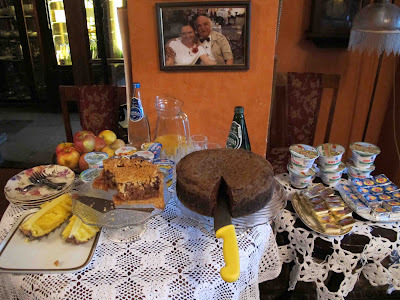 Breakfast at Klezmer Hois Photo (c) Ruth Ellen Gruber
Breakfast at Klezmer Hois Photo (c) Ruth Ellen Gruber
The other hotel in Kazimierz that I stay in is the Hotel Eden, on Ciemna street, a wonderfully friendly place, founded in the mid-1990s by the American Allen Haberberg, that started out as a kosher hotel. Though no longer kosher, the Eden still caters to Jewish travelers and has a mikvah -- which has been used for conversions as well as ritual baths. Each room has a mezuzah on the door, and there is also wifi throughout the building. I asked Allen not long ago why the Eden was no longer kosher (although it will still provide kosher food for those who ask) -- he told me one reasons was that there are now good kosher caterers as well as an upscale kosher restaurant (the Olive Tree) in Krakow.
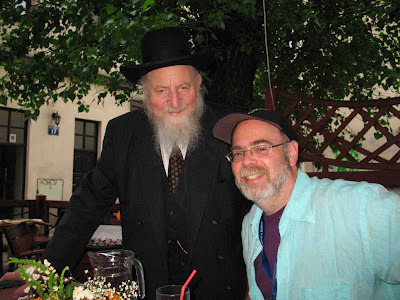 Rabbi Edgar Gluck and Allen Haberberg outside the Hotel Eden Photo (c) Ruth Ellen Gruber
Rabbi Edgar Gluck and Allen Haberberg outside the Hotel Eden Photo (c) Ruth Ellen Gruber
Also on this trip though, for the first time in a long time, I stayed for a couple of nights near the Rynek, at the Hotel Saski -- where I think I stayed with my mother in about 1992./
It doesn't seem to have changed much -- but the Old Town has.... Krakow is the city that doesn't sleep ... at 3 a.m. the streets were as lively as in the middle of the afternoon.
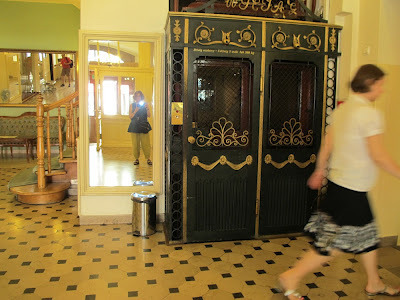 Lobby of the Saski. Photo (c) Ruth Ellen Gruber
Lobby of the Saski. Photo (c) Ruth Ellen Gruber

I've just been to Krakow for the last few days of the annual Jewish Culture Festival - the best party around. This year I did a couple of lectures to groups who were attending (and observing) the festival. It led to some reminiscing with friends who -- like me -- have been going to the Festival since the early 1990s.
One of the things we talked about what where we had stayed in Krakow in those early years -- because, until the late 1990s, there were very few if any places to stay in Kazimierz, the old Jewish quarter where the Festival now takes place.
In the early years, the artists at the Festival used to be put up at the Forum Hotel -- I should say, the late Forum Hotel, because the Forum as it was then does not exist anymore. It is a hulking empty relic that serves as a prop for huge advertising posters....
I used to stay at the Hotel Pollera, an old-fashioned place in the Old Town near the main market square, or Rynek, about a 20-minute walk (or more) from Kazimierz.
For the past dozen years, though, I've stayed in Kazimierz itself whenever I've been in Krakow -- usually at one of two hotels that, I have to say, are run by friends.
One is the Klezmer Hois, operated by Wojtek and Malgosia Ornat, the couple who founded the first Jewish-style cafe in Krakow. I still remember vividly sitting with Wojtek in 1992 or so, at an umbrella-shaded wicker table, eating strawberries and looking out at the devastation of Szeroka street, the main square of Jewish Kazimierz, which then was a ring of dilapidated buildings.
The Ornats opened Klezmer Hois -- their third locale -- in the mid-1990s, in a building that once housed a mikvah. It evolved into a hangout for Krakow Jews and visiting Jewish artists and others -- and it still fulfills that purpose, at least for us older crowd. Sitting in the garden during Festival time, is a delight, a constant round of people dropping by, conversing, eating, drinking. Klezmer Hois is, actually, the one "Jewish style" cafe in Krakow that I go to. The Ornats also run the Austeria Jewish publishing house (which has published my book "Letters from Europe (and Elsewhere)") and the associated Austeria bookstore.
The hotel rooms are old-fashioned and up creaking flights of stairs -- and the breakfast is spectacular, a delicious combination of table service and partial buffet.
 Breakfast at Klezmer Hois Photo (c) Ruth Ellen Gruber
Breakfast at Klezmer Hois Photo (c) Ruth Ellen GruberThe other hotel in Kazimierz that I stay in is the Hotel Eden, on Ciemna street, a wonderfully friendly place, founded in the mid-1990s by the American Allen Haberberg, that started out as a kosher hotel. Though no longer kosher, the Eden still caters to Jewish travelers and has a mikvah -- which has been used for conversions as well as ritual baths. Each room has a mezuzah on the door, and there is also wifi throughout the building. I asked Allen not long ago why the Eden was no longer kosher (although it will still provide kosher food for those who ask) -- he told me one reasons was that there are now good kosher caterers as well as an upscale kosher restaurant (the Olive Tree) in Krakow.
 Rabbi Edgar Gluck and Allen Haberberg outside the Hotel Eden Photo (c) Ruth Ellen Gruber
Rabbi Edgar Gluck and Allen Haberberg outside the Hotel Eden Photo (c) Ruth Ellen GruberAlso on this trip though, for the first time in a long time, I stayed for a couple of nights near the Rynek, at the Hotel Saski -- where I think I stayed with my mother in about 1992./
It doesn't seem to have changed much -- but the Old Town has.... Krakow is the city that doesn't sleep ... at 3 a.m. the streets were as lively as in the middle of the afternoon.
 Lobby of the Saski. Photo (c) Ruth Ellen Gruber
Lobby of the Saski. Photo (c) Ruth Ellen Gruber
Published on July 12, 2012 14:20



